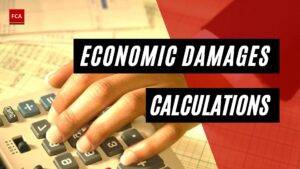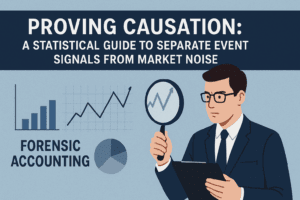Calculating Economic Damages & Lost Profits accurately remains one of the most challenging aspects of financial litigation nationwide. When businesses suffer economic harm, they require methodical, defensible calculations to secure fair compensation. Forensic accountants and economic damages experts play a crucial role in this process, applying business valuation principles to quantify losses that would otherwise remain theoretical.
Furthermore, courts increasingly scrutinize the methodologies behind lost profits claims, demanding expert witnesses demonstrate transparent, replicable approaches. This comprehensive guide examines court-tested methods for calculating economic damages, from historical benchmarking to competitive displacement modeling. You’ll learn how to develop robust damage models that withstand cross-examination, properly account for cost structures, and validate your assumptions with multiple data sources. Essentially, this article provides the analytical framework needed to construct economic damage calculations that meet the highest standards of judicial scrutiny.
Understanding the Legal Basis for Lost Profits Claims
The legal foundation for lost profits claims varies significantly based on the nature of the harm and the relationship between parties. Before forensic accountants and economic damages experts can begin their analysis, they must understand the precise legal framework that governs each case.
Tort vs. Contractual Damages Framework
Lost profits damages are treated distinctly depending on whether they stem from tortious conduct or contractual breaches. Courts generally apply different standards of proof and causation requirements for each type of claim. In tort cases, damages aim to restore the plaintiff to the position they would have occupied absent the wrongful act. Conversely, contractual damages focus on fulfilling the economic expectations created by the agreement.
Courts often exhibit greater skepticism toward lost profits claims in tort cases, viewing them as potential “surplus recovery” beyond making the plaintiff whole. For this reason, courts have established strict requirements that plaintiffs demonstrate their losses with “reasonable certainty” [1]. Additionally, many jurisdictions apply the economic loss rule, which prevents recovery for negligence when the duty breached is contractual and the harm results from failure of the contract’s purpose [2].
Expectation vs. Reliance Damages in Business Disputes
Expectation damages represent the most common framework in business contract disputes, designed to place the non-breaching party in the same financial position they would have achieved had the contract been performed as promised [3]. This “benefit of the bargain” approach requires comparing:
- The financial position the claimant would have occupied if the respondent had performed (the “but-for position”)
- The actual financial position given the effects of the breach [3]
In contrast, reliance damages restore the plaintiff to the position they would have occupied had the relationship with the defendant never existed [4]. These damages typically include wasted expenditures made in furtherance of contractual duties [4]. Economic damages experts must understand that:
- Expectation damages apply primarily to breach of contract claims where the wrongdoing is failure to perform
- Reliance damages generally apply to torts and some contract breaches, compensating for out-of-pocket costs [5]
Lost profits may be considered either direct or consequential damages depending on specific circumstances. They are direct when “part and parcel of the contract itself,” but more commonly classified as consequential when involving profits expected from collateral agreements with third parties [1].
The Role of the ‘But-For’ Scenario in Economic Loss
At the core of economic damages calculation lies the “but-for” analysis—an assessment comparing what actually happened with what would have happened absent the harmful event. This analysis serves as the fundamental starting point for quantifying economic loss across all damages theories.
The but-for scenario requires economic damages experts to construct a coherent counterfactual that isolates the financial impact of the conduct at issue [6]. Although hypothetical by definition, this scenario must remain internally consistent and supported by evidence like management projections, historical trends, peer performance data, or contract terms themselves.
Constructing the but-for scenario demands comprehensive analysis of:
- The precise characterization of the harmful event
- A clear description of what would have occurred without the wrongdoing
- The causal link between the wrongful act and the claimed harm [7]
This methodology applies across various case types—from straightforward personal injury matters to complex commercial disputes involving multiple variables and market forces. The but-for scenario establishes the benchmark against which actual performance is measured, allowing for the calculation of damages that truly reflect the economic impact of the harmful event.
Court-Tested Methods for Calculating Lost Profits
Forensic accountants rely on several court-tested methodologies when calculating lost profits and economic damages. These approaches have gained widespread judicial acceptance through decades of application in commercial litigation. Each method offers distinct advantages depending on the specific circumstances of the case, available data, and nature of the business claiming damages.
Before-and-After Method: Historical Benchmarking
The Before-and-After Method stands as probably the most reliable approach for proving lost profits, gaining endorsement from courts in nearly every jurisdiction [8]. This approach compares a company’s financial performance during two distinct periods: the “loss period” when the business experienced harm from the defendant’s conduct and a “benchmark period” when it operated normally. The analysis typically focuses on key financial parameters such as net income, sales, or gross margin [8].
Ideally, analysts employ three periods rather than two: a benchmark period before the harmful event, the loss period itself, and a second benchmark period after effects have subsided [8]. This triangular approach strengthens the analysis by establishing clearer patterns of performance. Moreover, the Supreme Court endorsed this method in the landmark case Bigelow v. RKO Radio Pictures, Inc., where movie theater owners successfully demonstrated damages by comparing receipts before and during a period when they were denied access to current films [8].
Nevertheless, proper application requires careful selection of the benchmark period. According to forensic accounting standards, the benchmark must serve as a “reliable indicator” of what performance would have been absent the harmful conduct [8]. Consequently, analysts must also identify and adjust for any confounding factors beyond the defendant’s actions that might have affected performance differences.
Yardstick Method: Comparable Company Analysis
Meanwhile, the Yardstick Method benchmarks a damaged company’s performance against external sources, such as similar businesses or industry guidelines [9]. The underlying assumption is that the plaintiff’s business would have performed comparably to its competitors if not for the harmful act [9]. This approach proves especially valuable when analyzing new businesses with limited operating history or when market conditions changed significantly during the damages period [10].
In particular, selecting appropriate comparable companies requires rigorous analysis. As demonstrated in Washington v. Kellwood Co., courts accept the method even when comparable aren’t perfectly identical, since the “selection of comparators will seldom approach the ‘utopian ideal'” [11]. When selecting comparison companies, experts should consider:
- Similar product offerings and market focus
- Comparable business models and distribution channels
- Relevant geographic reach and cultural influence
- Similar marketing strategies and growth potential [11]
However, courts typically scrutinize this method more heavily when applied to start-up companies, requiring experts to thoroughly justify their selection of comparables [11].
Sales Projection Method: Forecast-Based Estimation
The Sales Projection Method utilizes company-specific forecasts to establish the basis for damages calculations [9]. This approach relies on projections or forecasts of expected cash flows, ideally created in the ordinary course of business rather than specifically for litigation [10]. Therefore, many courts have concluded this method produces reliable results when properly executed [12].
Notably, this technique proves particularly valuable for niche players and start-ups with limited operating history and few meaningful comparables [9]. However, experts must ensure forecasts have a “reasonably objective basis” as defined by accounting standards [13]. This requires careful analysis of underlying assumptions and adjustment for any litigation-driven bias in projections.
Market Share Method: Competitive Displacement Modeling
The Market Share Method determines damages based on the plaintiff’s market share prior to the harmful event [12]. This approach calculates what percentage of the market the plaintiff would have captured absent the defendant’s actions, then quantifies the corresponding revenue loss [10]. In fact, this method works especially well when robust industry data exists and when the plaintiff has an established track record of market performance [14].
For effective application, experts must define the relevant market, demonstrate what share would have been achieved but-for the defendant’s breach, and establish the profit margin on increased sales [12]. Subsequently, this analysis reveals how competitors may have displaced the plaintiff’s position in the marketplace. This methodology frequently appears in patent infringement cases but applies equally well to other commercial disputes when appropriate data is available [12].
Revenue and Cost Structure Analysis
Accurate revenue and cost analysis forms the backbone of credible lost profits calculations in economic damage cases. Forensic accountants must meticulously examine financial data to establish what would have occurred absent the harmful event.
Estimating But-For Revenue Using Historical Trends
The foundation of any damages calculation begins with thorough examination of revenue and sales data [15]. Creating but-for revenue estimates involves comparing projected figures to actual post-event performance. This process typically includes analyzing market share changes, adjusting for seasonal fluctuations, assessing expected growth rates, and evaluating market penetration capabilities [15]. Revenue forecasts provide estimated projections of total revenues expected in future periods [16], ranging from short-term pipeline conversion to long-range market predictions.
Avoided Costs vs. Incremental Costs in Lost Sales
Accurate profit calculations require identifying costs the business would have incurred (incremental) versus those it avoided due to lost sales. Avoided costs represent expenses that would have been incurred in connection with generating projected lost revenues [17]. These typically include direct materials, variable labor, and other costs that fluctuate with production volume. Identifying avoided costs involves reviewing financial statement categories for variable-cost descriptions, conducting regression analysis using revenue and expense data, and examining contracts or testimony that establish cost structures [1].
Fixed vs. Variable Cost Allocation in Damage Models
Proper allocation between fixed and variable costs is crucial for accurate damage calculations. Fixed costs do not change with production volume, while variable costs fluctuate directly with output levels [2]. Examples of fixed costs include rent, interest payments, and salaried staff compensation [2]. Variable costs include raw materials, direct labor for hourly workers, and utilities that increase with production [2]. Regression analysis can help identify the variable component of mixed expenses—those containing both fixed and variable elements [1]. The slope in regression analysis quantifies the ratio of variable costs to sales, while the intercept represents fixed costs [1].
Extraordinary Expenses and One-Time Adjustments
Damage models must account for extraordinary expenses resulting from the defendant’s actions [15]. These include: – Extra expenses incurred during restoration periods that help minimize business suspension [17] – Costs related to temporary operations at replacement locations [17] – One-time expenditures for recovery efforts [17] – Unusual financing costs stemming from the incident [15]
Expert analysis must distinguish between ordinary business expenses and those directly attributable to the harmful event. Despite including extraordinary costs in damages calculations, courts expect plaintiffs to mitigate losses through reasonable efforts—a consideration forensic accountants must incorporate into their analyzes [18].
Validating Assumptions and Data Sources
Validating assumptions and data sources serves as the critical differentiator between speculative claims and defensible economic damage calculations. Even the most sophisticated lost profits analysis falters without proper validation techniques.
Using Industry Benchmarks and Market Reports
Forensic accountants rely on industry-specific comparisons to demonstrate the reasonable nature of lost profit calculations. A proper damages analysis requires selecting appropriate benchmarks that accurately reflect the plaintiff’s business circumstances [19]. During economic damages valuation, experts analyze industry benchmarks alongside historical performance data to establish a credible baseline for projected revenue and expenses [20]. This approach proves particularly valuable when applying the Yardstick Method, where comparing a damaged business to similar companies substantiates claimed damages [14].
Testing Forecasts Against Historical Performance
Forecast backtesting represents a crucial validation technique that compares historical forecasts against actual collected data to quantify deviation between predicted and actual trends [3]. This process allows experts to assess forecast sensitivity to training period selection, identify the impact of outliers, and evaluate the accuracy of longer-range projections [3]. By default, analytical tools typically create forecast periods spanning half the training period, though experts may adjust this timeframe to specific requirements [3].
Identifying Biased or Litigation-Driven Projections
Common forecasting errors include relying exclusively on industry experts with limited litigation experience or trusting theoretical projection models without tangible support [21]. Forensic accountants must detect projection bias by examining underlying assumptions for litigation-driven optimism. Using historical data as the foundation for forecasts helps anchor predictions in reality [22]. First-rate experts run multiple scenario analyzes to consider various factors that could influence performance, thus mitigating biased predictions [22].
Triangulating with Multiple Data Inputs
Just as backcountry navigators take multiple bearings to determine position, damage experts employ triangulation methods using various data sources [23]. This approach provides different “bearings” that collectively improve forecast accuracy [23]. For instance, comparing rep-level forecasts (typically optimistic) with manager-level forecasts (often more accurate) alongside stage-weighted and category-weighted expected values creates a comprehensive picture [23]. This multi-dimensional validation approach enhances credibility in litigation settings.
Discounting, Tax, and Prejudgment Interest Considerations
Financial considerations beyond basic loss calculations play a pivotal role in economic damages analysis. Forensic accountants must account for time value of money, tax implications, and interest factors to accurately restore injured parties to their rightful position.
Present Value Discounting of Future Losses
The present value of damages represents the sum needed today to fund future expenditures at their inflation-adjusted values [24]. This concept recognizes that money available immediately has greater value than money received later. For this purpose, experts apply discount rates that reflect both the time value of money and associated risks.
Indeed, selecting the appropriate discount rate profoundly impacts final calculations—even a single percentage point difference can alter damages by over $100,000 in a ten-year cash flow stream [25]. Courts typically consider several potential rates, including:
- Treasury bill/bond rates (risk-free rate)
- The defendant’s unsecured borrowing rate
- The plaintiff’s cost of capital
- Contractual rates between parties [4]
After-Tax vs. Pre-Tax Damage Calculations
Tax considerations often remain overlooked yet crucial elements in damages assessment. The addition of income taxes to awards—known as “tax gross-up”—ensures plaintiffs reach the same financial position they would have achieved absent the injury [26].
Courts have varied in their approach to taxation. Some jurisdictions follow the principle established in R. v. Jennings, where the Supreme Court held that income taxes should not be deducted from lost income calculations [27]. The court reasoned that taxation represents “a disposition of a portion of earned income required by law” rather than an element of cost [27].
Prejudgment Interest: Simple vs. Compound Models
Prejudgment interest compensates plaintiffs for being denied use of money between the harmful event and judgment date [28]. This calculation addresses two foundational financial principles: current dollars hold greater value than future dollars, plus safer dollars exceed risky ones in value [4].
Simple interest, calculated solely as a percentage of the principal, traditionally prevailed in common law [6]. Conversely, compound interest—which calculates interest on accumulated prior interest—better reflects commercial reality [6]. The difference between methods grows with longer prejudgment periods, higher interest rates, and more frequent compounding intervals [4].
Jurisdictional Variations in Interest Application
Interest calculation practices vary substantially across jurisdictions. Some states establish fixed statutory rates while others tie rates to established indexes [6]. This variation creates significant disparities in final awards—identical damages occurring 10-15 years ago could increase by 66% in the UK versus tripling in the Netherlands due to different calculation methodologies [29].
Federal courts recognize prejudgment interest as “an element of complete compensation” without mandating specific rates [6]. Meanwhile, state provisions range widely—Wisconsin uses prime rate plus 1%, Illinois applies 6% annually, and New York maintains 9% (except for consumer debt cases at 2%) [7]. Hence, forum selection becomes a critical strategic consideration in damages litigation.
Conclusion
Calculating economic damages requires meticulous attention to methodology, data validation, and legal frameworks. Throughout this guide, we explored how forensic accountants and economic experts develop defensible calculations that withstand judicial scrutiny. The legal basis for lost profits claims significantly influences the approach, whether dealing with tort or contractual damages, expectation or reliance theories, or constructing the essential but-for scenario.
Court-tested methodologies provide reliable frameworks for quantifying economic harm. The Before-and-After Method offers historical benchmarking advantages when sufficient pre-incident data exists. Alternatively, the Yardstick Method compares performance against similar businesses, while the Sales Projection Method utilizes forecasts for businesses with limited history. Market Share analysis proves particularly valuable when robust industry data demonstrates competitive displacement.
Revenue and cost structure analysis forms the backbone of credible calculations. Experts must differentiate between avoided and incremental costs while properly allocating fixed versus variable expenses. Extraordinary one-time costs require special consideration to accurately reflect actual damages.
The credibility of any damages calculation ultimately depends on rigorous validation techniques. Experts enhance reliability through industry benchmarks, testing forecasts against historical performance, identifying potential biases, and triangulating multiple data sources. This multi-dimensional approach strengthens conclusions and preemptively addresses potential challenges.
Financial considerations beyond basic calculations also play a crucial role. Present value discounting acknowledges the time value of money, while tax implications determine whether after-tax or pre-tax models apply. Prejudgment interest varies substantially across jurisdictions, potentially creating significant disparities in final awards.
Economic damages calculation remains both art and science. Forensic accountants must balance mathematical precision with reasonable judgment, always maintaining transparency about assumptions and methodologies. Essentially, the most defensible calculations combine robust analytical frameworks with comprehensive data validation. When properly executed, these approaches provide the factual foundation necessary for fair compensation in complex financial litigation.




